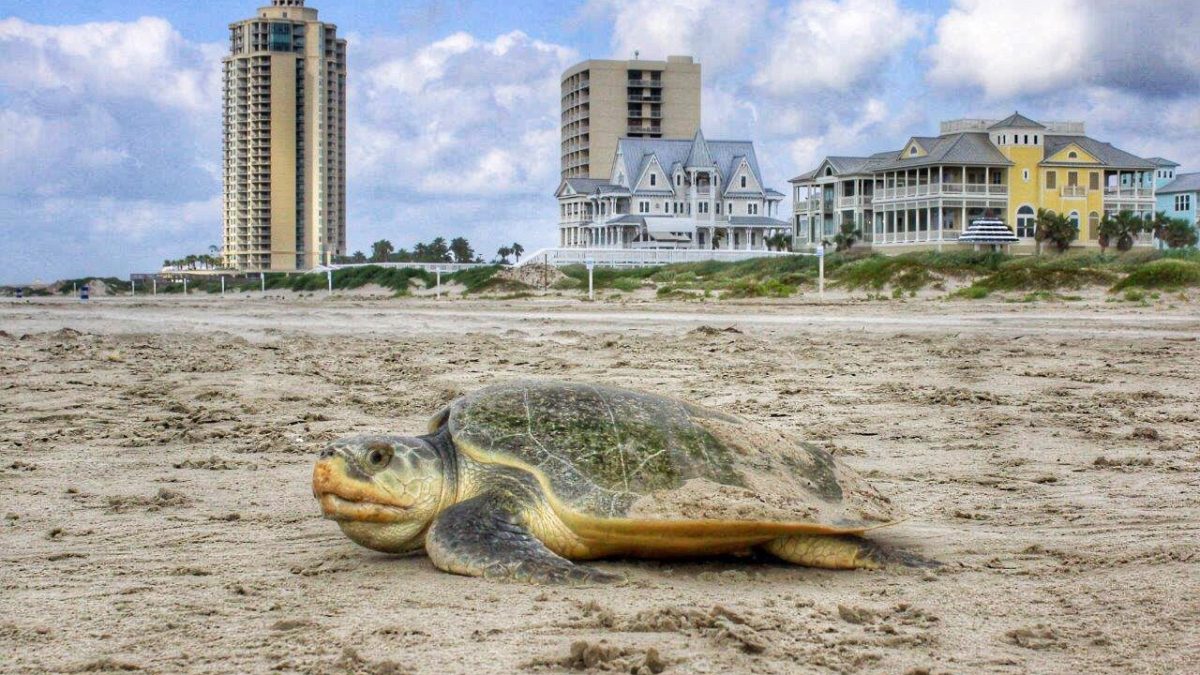The Impact of Coastal Development on Sea Turtle Populations

A nesting Kemp's ridley turtle next to a housing development (Photo Credit : Turtle Island Restoration Network)
Coastal regions are vital ecosystems that support a wide variety of marine life, including the iconic sea turtles. However, as coastal development accelerates due to population growth and urbanization, these fragile ecosystems are facing serious threats. One of the most affected species is the sea turtle, whose populations have been steadily declining because of multiple human-driven factors. Studies have shown that coastal development is a key contributor to this alarming trend (López-Mendilaharsu, M. et al., 2020; Abelson, A. et al., 2020).
Loss of Habitat
One of the most direct impacts of coastal development is the loss of vital habitats for sea turtles. As more people move to coastal areas to live, work, and vacation, human activity disrupts the natural environment. Coastal infrastructure projects, including roads, hotels, and other tourist facilities, often encroach on critical nesting and foraging areas for sea turtles.
An example of this issue is found on the island of Kepulauan Seribu in Indonesia, a popular tourist destination close to Jakarta. The island's coral reefs and sandy beaches are vital nesting grounds for several species of sea turtles, including the endangered green and hawksbill turtles. However, rapid urbanization and infrastructure development in the region have caused significant habitat loss. The expansion of tourism-related facilities, including resorts and beachfront properties, has led to the destruction of key nesting areas. In addition, the construction of roads and jetties has blocked turtle access to the beaches, further exacerbating the problem.
These types of developments not only damage the turtles' physical habitats but also disrupt their behavior. Sea turtles rely on specific areas along coastlines for nesting, where they return to lay their eggs each year. When these areas are disturbed or degraded, the turtles' ability to reproduce is compromised, leading to declining population numbers.
Pollution and Water Quality
Coastal development also brings with it increased pollution, which poses a severe threat to sea turtle populations. Wastewater from sewage, industrial runoff, and urban pollution can contaminate the surrounding marine environment. These pollutants can disrupt the delicate balance of the ecosystems where sea turtles feed and breed. Polluted waters can harm sea turtle hatchlings, disrupt their development, and affect their health.
For example, polluted waters can carry harmful chemicals and toxins that can accumulate in the food chain, affecting the sea turtles' diet. This contamination can have long-term effects on their reproductive success and survival rates. Furthermore, pollutants such as plastics and other debris are often ingested by sea turtles, which can lead to injury or death (Jeong, Eunju 2024).
Light Pollution
Artificial light has been shown to have a disruptive effect on sea turtle hatchlings during their journey from the beach to the ocean. In a recent study, hatchlings exposed to artificial light were found to be attracted to it, with 88% of them changing their direction towards the light. As a result, these hatchlings spent more time in the tracking area compared to those under natural lighting conditions. This behavior likely increases their vulnerability to predators, as they may become disoriented and travel in unsafe directions. The study provides valuable insights into how light pollution can interfere with the natural navigation of hatchlings, a crucial phase of their early life.
The research also explored the role of environmental factors, such as ocean currents, on hatchling behavior. While currents had little impact on the hatchlings' direction under artificial light, they did influence their movements when natural light conditions prevailed. This study represents the first experimental evidence that artificial lighting affects the movement of wild turtle hatchlings once they enter the ocean. Understanding these impacts can help guide conservation efforts to reduce light pollution and protect sea turtle populations. (Thums, M. 2020).
Conservation Efforts
Recognizing these threats, numerous conservation organizations and governments have started to take action to protect sea turtle populations. Efforts include habitat restoration, pollution control, and the establishment of protected areas where human activity is restricted. Additionally, programs to educate the public about the impacts of coastal development and the importance of preserving natural habitats have gained momentum.
In conclusion, coastal development, while often seen as a sign of economic progress, poses significant challenges to the survival of sea turtles. The loss of habitat, pollution, and other impacts threaten the delicate balance of coastal ecosystems. Through careful planning, sustainable development, and continued conservation efforts, we can help ensure that future generations of sea turtles continue to thrive in their natural habitats.
-Rika Novida
References
Abelson, A et.al., (2020), Challenges for Restoration of Coastal Marine Ecosystems in the Anthropocene
Jeong, E (2024) Animal exposure to microplastics and health effects: A review. Emerging Contaminants. Volume 10, Issue 4, December 2024, 100369
López-Mendilaharsu, M (2009) Insights on leatherback turtle movement and high use areas in the Southwest Atlantic Ocean
Thums, M. et.al., (2016) Artificial light on water attracts turtle hatchlings during their near shore transit.

